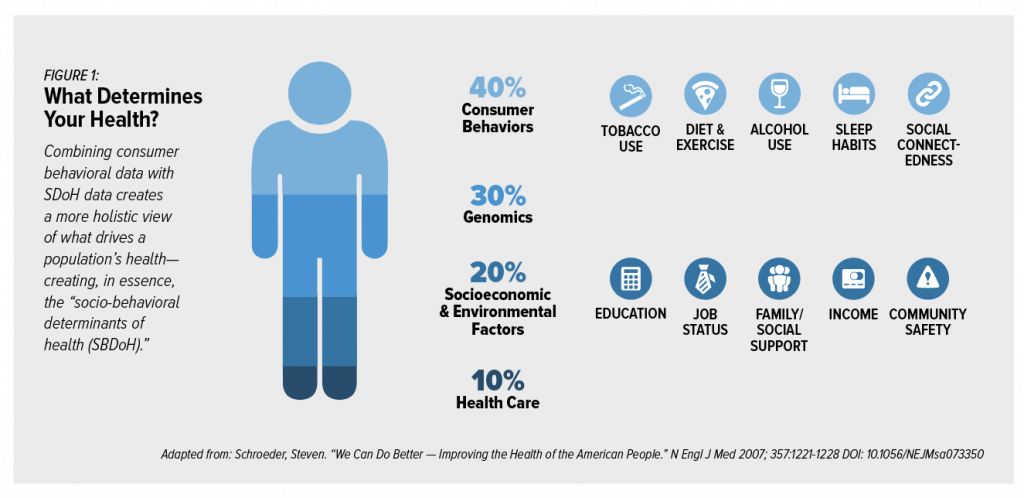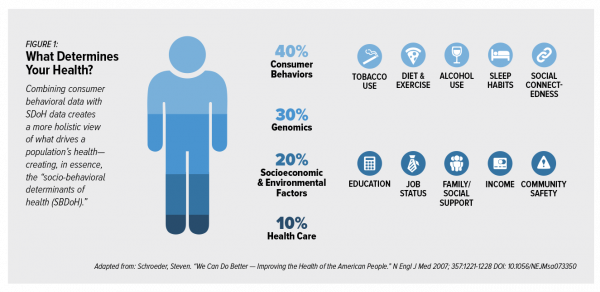 “Health agencies will have to become at least as sophisticated as other consumer/retail industries in analyzing a variety of data that helps uncover root causes of human behavior,” Gartner recommended in 2017.
“Health agencies will have to become at least as sophisticated as other consumer/retail industries in analyzing a variety of data that helps uncover root causes of human behavior,” Gartner recommended in 2017.
That’s because “health” is not all pre-determined by our parent-given genetics. Health is determined by many factors in our own hands, and in forces around us: physical environment, built environment, and public policy.
These are the social determinants of health, but knowing them even for the N of 1 patient isn’t quite enough to help the healthcare industry move the needle on outcomes and costs. We need to understand human behavior, as well, advocates Zip Codes Alone Don’t Deliver, a report from Sage Growth Partners.
The Sage team explains that, by layering knowledge about peoples’ behaviors, beliefs, and attitudes on top of the traditional SDOH factors, health care providers can mash-up SBDoH – “socio-behavioral determinants of health” — your new acronym to add to your growing list of healthcare ABCs.
The paper presents several case studies where providers and payors adopted SBDoH in population health strategies:
- To reduce teen pregnancy, The University of Texas Prevention Research Center at UT Health School of Public Health worked with young women in the Sunnyside neighborhood in Houston to identify population segments, learning about teens’ use of cell phones for texting and web-surfing, consumption of magazines, and “outspoken” attitudes. The targeted prevention programs channeled through schools and churches as well as on-line, increasing engagement in the at-risk population and resulting in a 20% decline in teen pregnancy over 3 years.
- To optimize communication strategies for attracting Medicare Advantage enrollment, a Mid-Atlantic health plan studied the media and social consumption patterns for older people, learning that the target population was more tech-savvy than presumed. Leveraging SBDoH data led the plan to save over one million dollars while developing an effective marketing strategy. The health plan will further leverage the data to better-design health plan products.
- To more effectively help patients manage diabetes, CentraForce Health used geospatial mapping of SBDoH data to develop deeper insights into peoples’ health needs and behaviors — such as eating fast food in the past 30 days, sufficient time to eat healthy food, and tendency to follow a doctor’s recommendations.
This report was published just-in-time as we convene to meet at HIMSS 2018, the largest annual health technology conference. Last year I gave a talk about social determinants of health at HIMSS, which hadn’t been a topic that was much-discussed in previous years’ meet-ups. This year at #HIMSS18, there are many talks featuring case studies on the topic, which has finally gained the front-of-mind attention it deserves in health care.
Health Populi’s Hot Points: As Gartner advises us to put our consumer/retail lenses on when considering peoples whole-health lives, I turn to the latest news about the AAAs in tech — Amazon, Apple, and Alphabet — and offer some audacious advice on addressing SBDoH.
Amazon most recently announced expanding its offerings in the store retail pharmacy of private-labelled over-the-counter products. The company’s alliance with Berkshire-Hathaway, led by Warren Buffett, and JP Morgan (JPM), begs some SBDoH solutions beyond the promise of a new model for employer-sponsored healthcare:
Amazon could drop the price of Prime subscriptions to people enrolled in Medicaid, as well as people with SNAP (food) benefits, to close to zero, with the plan sponsors (State and Federal governments) fully subsidizing the memberships for the ordering of healthy food and prescribed medicines (for now, over-the-counter). This would break down a barrier for people living in food and/or pharmacy deserts.
Warren Buffett could divest companies in his investment portfolio that represent industries in processed foods, sugar, tobacco, guns, and other products that diminish public and individual health. We’ve seen Danone (Dannon) and CVS/health moving in this direction.
JPM could help bank the unbanked — people without bank accounts. This can be done in a variety of ways, such as siting new storefront locations in bank-desert locales, working through community centers like the Y, and educating young students on saving and financial planning. Better yet, organize the banking access on-ramp on smartphones, the way microfinancing is done in much of Africa these days.
Apple‘s new clinic model being developed for employees could be re-purposed for a new-fangled FQHC concept, with information kiosks sited where people live, work, play, pray and learn.
Alphabet (Google) company Verily is looking to drive down health insurance costs through the savvy use of data. Surely, Google can wrangle SBDoH data in a health insurance model for uninsured people, right?
All of these companies are brilliant users of data, which will increasingly be the currency that, wisely used and designed with UX and privacy in mind, could make healthcare better for people. Many of us attending #HIMSS18 will be firmly focused on this audacious and necessary goal next week in Las Vegas.





 Thanks to Feedspot for naming this blog, Health Populi, as a
Thanks to Feedspot for naming this blog, Health Populi, as a